Warning! Do not forget that gasoline is a highly flammable liquid! Observe all applicable fire safety precautions when working on power system components. Do not smoke, do not approach the work area with an open flame or an unprotected carrier. Do not service the system in a room equipped with natural gas-fired, pilot flame-equipped heaters (such as water heaters and clothes dryers). Do not forget that gasoline is one of the carcinogenic substances that contribute to the development of cancer. Try to prevent fuel from getting into open areas of the body - use protective rubber gloves, in case of accidental unforeseen contact, thoroughly wash your hands with warm water and soap. Clean up spilled fuel immediately and do not store fuel-soaked rags near open flames. Remember that the fuel injection system of models equipped with fuel injection is constantly under pressure. Relieve any residual pressure in the system before disconnecting fuel lines (see chapter Power and exhaust systems). Wear safety goggles when servicing power system components. Keep a class B fire extinguisher handy at all times!
The air conditioning system path is also constantly under pressure, and therefore, before disconnecting the refrigeration lines, it is necessary to discharge the system in a specialized workshop.
The cars of this model are equipped with an SRS system, the main component of which is airbags. Always turn off the system before doing any work near the location of the SRS directional g-force sensors, in the area of the steering column or instrument panel, to prevent accidental deployment of airbags, which is fraught with serious injury.
Removing
Note. Before proceeding with the procedure, carefully read the material in this Section. Manufacturers recommend removing the engine from the vehicle complete with transmission. The dismemberment of the power unit can be done later on the floor of the workshop.
1. Relieve the pressure in the supply system (see chapter Power and exhaust systems).
2. Disconnect the negative cable from the battery.
Attention! If the stereo system installed in the car is equipped with a security code, before disconnecting the battery, make sure that you have the correct combination to activate the audio system!
3. Cover the fenders and the air baffle under the windshield of the car with special protective covers, or just old blankets. Remove the hood (see chapter Body).
4. Remove the air cleaner assembly (see chapter Power and exhaust systems).
5. Jack up the car and put it on stands. Drain the cooling system, drain the engine oil and remove the accessory drive belts (see chapter Settings and ongoing maintenance).
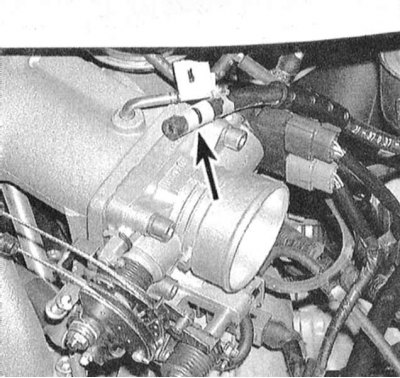
6. Clearly label and disconnect all vacuum lines, cooling and emission control hoses, electrical wiring connectors, grounding bars, and fuel lines from the engine. Marking electrical wiring, lines and hoses is best done with adhesive tape. It will also be useful to draw up a scheme for laying communications, or to take a series of successive photographs.
7. Remove the cooling system fans, disconnect the radiator hoses and heating path hoses (see chapter Cooling, heating systems).
8. After removing the filler cap, release the residual pressure in the fuel tank, then disconnect the fuel lines coming from the fuel line (see chapter Power and exhaust systems). Seal the open ends of pipes and fittings immediately.
9. Loosen and move the air conditioning compressor to the side without disconnecting the refrigeration lines from it.
10. Disconnect the accelerator rod from the engine, and, if the vehicle is equipped accordingly, also the tempostat cable (see chapter Power and exhaust systems).
11. Unbolt the steering pump, move it to the side and tie it up without disconnecting the hydraulic lines (see chapter Suspension and steering). Remove generator (see chapter Engine electrical equipment).
12. On SOHC engines, remove the ignition coil and distributor with BB wires connected to it (see chapter Engine electrical equipment).
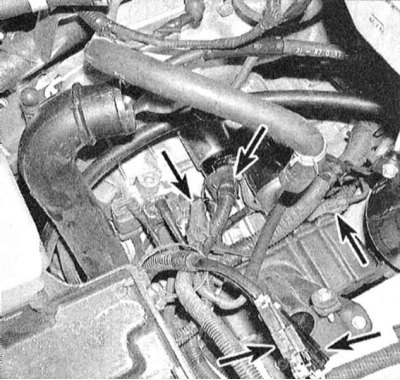
13. Mark and disconnect from both parties of the engine plaits of the main braid of electroconducting.
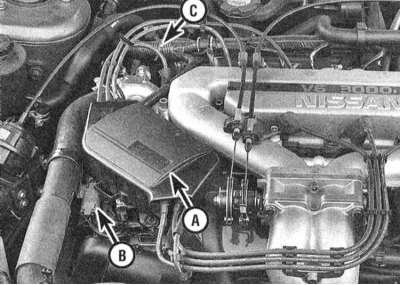 | 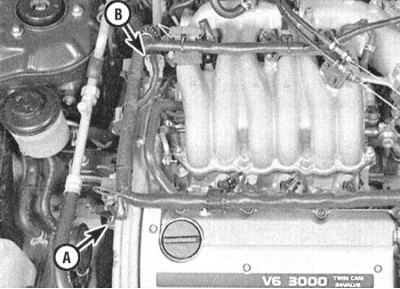 |
14. Remove the top section of the inlet pipeline (see part DOHC engines or SOHC engines this chapter), - do not forget to pre-mark all wires, hoses and busbars to be disconnected to ground.
15. Disconnect the exhaust pipe from the exhaust manifolds of the engine and the catalytic converter and remove it from the vehicle (see chapter Power and exhaust systems).
16. Remove drive shafts (see chapter Clutch and drive shafts). Disconnect the electrical wiring and gear shift rods from the transmission (see chapter Transmission).
17. Attach slings to power unit lifting eyes, turn winch on with slings fully slack.
Attention! If the power package is not equipped with lifting eyes, place slings/chains behind both cylinder heads. Suspend the unit, completely unloading its suspension supports.
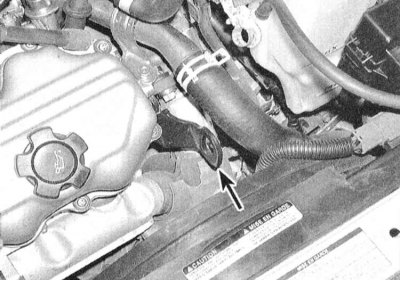 | 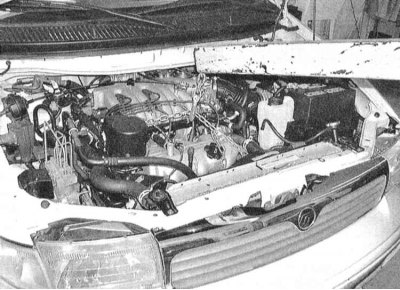 |
18. Make sure that nothing remains connected to the power unit and does not interfere with its removal from the car.
19. Support the transmission with a trolley jack, placing a wooden block under its head to distribute the load. Turn out bolts of fastening of support to the engine and a bearing crossbeam to the chassis (see part DOHC engines or SOHC engines this chapter).
Attention! Make sure that the unit is securely fixed in the raised position.
20. Slowly lower the powertrain assembly to the floor under the vehicle's engine compartment.
21. Disconnect the lifting rigging from the unit, hook it onto the car body, raise the latter to a sufficient height and remove the engine assembly from under the car.
Note. At this stage, it would be wise to enlist the support of an assistant.
22. Separate the engine from the transmission (see chapter Transmission).
23. Place the separated engine on the floor, or remove the flywheel/drive plate and secure the assembly to a mounting stand.
Installation
1. Check the condition of the power unit suspension mounts. Replace defective components.
2. On models with manual transmission, check the condition of the clutch components (it will be correct to replace the entire assembly) (see chapter Clutch and drive shafts). On models with AT, evaluate the condition of the seals and bushings of the rotation converter. Lubricate the guide bearing with high temperature grease (models with manual transmission) /converter nose (models with AT).
3. Carefully connect the transmission to the engine (see chapter Transmission).
Attention! Under no circumstances should the mounting bolts be used to force the transmission to the engine!
4. Screw in bolts of fastening of the engine to transmission and strongly tighten them.
5. Get the assembly of the power unit under the car, lifting it on the jack to the proper height, then lower the car body hung on the winch.
6. Rehook the rigging to the unit and carefully hang it in the engine compartment.
7. For reliability, support the engine with a jack, then put the cross beam into place. Screw in the appropriate fixing bolts (beams and supports) and tighten them to the required torque.
Note. Refer to the last Parts Sections for a description of how to finish tightening the powertrain suspension mounting hardware SOHC engines and DOHC engines of this chapter.
8. Install the remaining components in the reverse order of their dismantling.
9. Add engine coolant, engine oil, power steering fluid, etc., as needed. (see chapter Settings and ongoing maintenance).
10. Start engine and check for proper operation and signs of leaks, then shut off and check fluid levels.